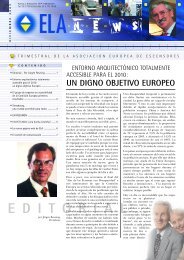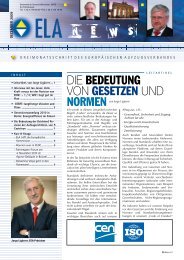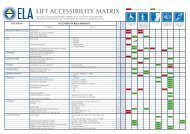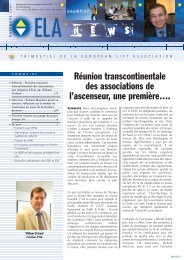WP6-Brochure-E4 brochure - ELA European Lift Association.
WP6-Brochure-E4 brochure - ELA European Lift Association.
WP6-Brochure-E4 brochure - ELA European Lift Association.
You also want an ePaper? Increase the reach of your titles
YUMPU automatically turns print PDFs into web optimized ePapers that Google loves.
Some manufacturers have gone even further, presenting solutions with 10:1 roping systems,<br />
avoiding the need for a counterweight and, therefore, freeing up space for a larger car. This<br />
product is directed at renovations since it is able to substitute older and more confined cars<br />
with bigger ones that can better accommodate wheelchairs or baby carriers, for example.<br />
Figure 2‐6. Space saved by avoiding the counterweight (source: KONE)<br />
Machine roomless (MRL) lifts were initially limited by factors such as travel height, speed and<br />
capacity, but nowadays they can be provided with travel distances of up to 80 m, capacities of<br />
eight (630 kg) to 21 people (1.600 kg), and contract speeds of up to 2,5 m/s.<br />
Another advantage of MRL lifts is that the high efficiencies of modern traction gearless<br />
machines used rarely require additional ventilation.<br />
MRL lifts offer alternative solutions without the limitations on speed and rise that may apply to<br />
a hydraulic installation and at competitive prices. Their market share is growing rapidly and is<br />
expected to make up 90 percent of new lift deliveries by 2020 [1].<br />
2.2 Hydraulic <strong>Lift</strong>s<br />
Hydraulic lifts are by far the most common type of lift installed in low rise applications (up to 6<br />
or 7 floors). One of the main reasons for its wide acceptance in some <strong>European</strong> countries is its<br />
relatively low initial cost.<br />
This type of lift uses a hydraulic cylinder to move the car. An electric motor drives a pump<br />
which forces a fluid into the cylinder. Valves control the fluid flow for a gentle descent,<br />
allowing the hydraulic fluid (usually oil) to flow back to the tank.<br />
In some cases, the cylinder is placed in a hole in the ground. Some types of holeless hydraulic<br />
lifts can be found in the market for low‐rise applications, which substantially reduce the risk of<br />
groundwater contamination. Due to restrictive laws in <strong>European</strong> countries, hydraulic lifts are<br />
usually of the telescopic cylinder or roped types.<br />
11

















